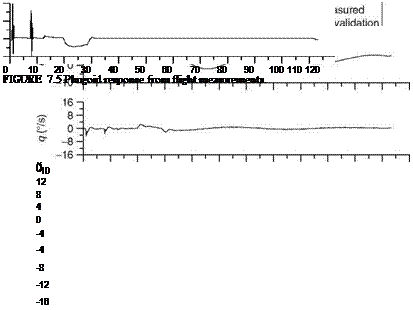Specific maneuvers for aerodynamic modeling
In this section many specific maneuvers are described for generating the flight test data that can be further processed in the parameter-estimation methods/SW for determination of the aerodynamic derivatives of the test aircraft.
7.6.1 Small Amplitude Maneuvers
The amplitude of the maneuvers is kept small so that the assumption of linearity is not violated and hence simple linear models can be used for parameter estimation.
7.6.1.1 Longitudinal Short-Period Maneuver
The short-period oscillation is the first one that the test pilot sees/feels after disturbing the airplane from its trim with the pitch control. Heavily damped signifies that the oscillation is damped within about two cycles after the completion of initial input. The short-period oscillation must be heavily damped both with controls fixed and free. The typical damping ratio would be 0.3 to 0.9, and the period is 1 to 4 s. The test for longitudinal dynamic stability is performed by a rapid movement of pulse of the control in a nose up and nose down direction at a rate and degree to obtain a short-period response. Dynamic longitudinal stability must be checked at a sufficient number of points in each flight test configuration. In a horizontal level trimmed flight with constant thrust, a doublet or 3-2-1-1 multistep command is applied to the pitch stick. One usually tries to avoid variations in the LD axes. Small corrections in the aileron and rudder positions are allowed if necessary. The time width of the input signal is appropriately selected to excite the short-period mode of the aircraft. The aircraft is trimmed at the required altitude and speed. Then the pitch stick is moved in the manner of the specified input signal (either doublet or 3-2-1-1). The mode is expected to be of 2-3 s duration and the data is recorded for about double the duration to cover the exponentially damped sinusoidal response. One can determine the longitudinal derivatives (Chapters 4 and 9) and also the neutral point of the aircraft from these flight test data (Chapter 9). Subsequently, the frequency and damping ratio of the short-period mode can be determined using MATLAB program. Typical SP maneuver flight-time histories are shown in Figure 7.4.
7.6.1.2 Phugoid Maneuver
As the mode is usually of 40-60 s duration (it could be even up to 120 s), longer data recording is required. A longer duration (10-15 s) pulse command input is applied to the pitch stick keeping the thrust constant. The aircraft is allowed to go through a minimum of one/two complete cycles (for about 2-3 min) of the phugoid oscillations before retrimming. One can determine the longitudinal phugoid-related (speed) derivatives of the aircraft from these flight test data. Subsequently, the frequency and damping ratio of the phugoid (long period) mode can be determined using the MATLAB program. The phugoid damping ratio would be 0.03 to 0.1. Typical phugoid maneuver flight-time histories are shown in Figure 7.5.
7.6.1.3 Thrust Input Maneuver
The thrust input maneuver is used to determine the effect of a thrust variation on the aircraft motion. Starting from trimmed level flight, a doublet variation in thrust is applied and the flight data recorded.
7.6.1.4 Flaps Input Maneuver
Flaps input maneuver can be used to gather information for estimation of flaps effectiveness derivatives. Data are generated by applying a doublet or 3-2-1-1 input to flaps. Other longitudinal controls and thrust are kept constant. Variations in the LD motion are kept small.
110 –
 |
-И 10090- 80-| 70-
Time (s)
FIGURE 7.4 Typical short period response in flight.
7.6.1.5 LD Maneuvers
Positive static directional stability is the tendency to recover from a skid with the rudder free. Positive static lateral stability is defined as the tendency to raise the low wing in a sideslip with the aileron controls free. Negative static lateral stability is not permitted unless the divergence is gradual and is easily recognizable and controllable by the pilot. For dynamic LD stability, the oscillation must be positively damped with controls free. It must be controllable with normal skills of use of the primary controls.
 |
Time (s)











